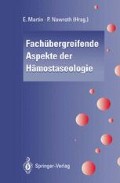Zusammenfassung
Es ist anerkannt, daß die „Gerinnung“ bei fast allen physiologischen und pathophysiologisehen zellulären Reaktionen beteiligt ist (s. unten). Diskrepant zu diesem breiten Anspruch der Hämostaseologie steht das Unwissen, denn außer dem Nachweis der Beteiligung der Gerinnung, kann in den meisten Fällen weder der molekulare Mechanismus, noch die physiologische Bedeutung der Beteiligung von Gerinnungsreaktionen in der Physiologie und Pathophysiologie angegeben werden.
Access this chapter
Tax calculation will be finalised at checkout
Purchases are for personal use only
Preview
Unable to display preview. Download preview PDF.
Literatur
Almendrai JM, Sommer D, MacDonald Bravo H et al. (1988) Complexity of the early genetic response to growth factors in mouse fibroblasts. Mol Cell Biol 8: 2140–2148
Altieri DC, Morrissey J, Edgington Th (1988) Adhesive receptor Mae-1 coordinates the activation of factor X on stimulated cells of monocytic and myeloid differentiation: An alternative initiation of the coagulation protease cascade. Proc Natl Acad Sci USA 85: 7462–7466
Davie EW, Ratnoff O (1964) Waterfall sequence for intrinsic blood clotting. Science 145: 1310–1311
Drake ThA, Morrisey JH, Edgington ThS (1989) Selective cellular expression of tissue factor in human tissues. Am J Pathol 134: 1087–1097
Esmon CT (1987) The regulation of natural anticoagulant pathways. Science 233: 1348–1352
Flier JS, Underhill LH (1992) Molecular and cellular biology of blood coagulation. New Engl J Med 326: 800–806
Nawroth P, Handley D, Esmon CT, Stern DM (1986) Interleukin-1 induces endothelial cell procoagulant while suppressing cell surface anticoagulant activity. Proc Natl Acad Sci USA 83: 3460–3464
Nawroth P, Handley D, Msatsueda G (1988) TNF-induced intravascular fibrin formation in meth-A fibrosarcomas. J Exp Med 168: 637–647
Nemerson Y, Bach R (1982) Tissue Factor revisited. Progr Hemost Thromb 6: 237–261
Ogawa S, Gerlach H, Esposito C et al. (1990) Hypoxia modulates the barrier and coagulant function of cultured bovine endothelium. J Clin Invest 85: 1090–1098
Stern DM, Nawroth P, Handley D, Kisiel W (1985) An endothelial cell dependent pathway of coagulation. Proc Natl Acad Sci USA 82: 2523–2527
Stern DM, Nawroth PP (guest) (1987) Vessel Wall. Seminars in Thrombosis and Hemostasis. Thieme Med Publ
Plate K-H, Breier G, Weicht H, Risau W (1992) Vascular endothelial growth factor is a potential tumor angiogenesis factor in human gliomas in vivo. Nature 359: 845–848
Plate KH, Breier G, Weicht H, Risau W (1993) Inhibition of vascular endothelial cell growth factor-induced angiogenesis suppresses tumor growth in vivo. Nature 362: 841–844
Virchow R (1865) Gesammelte Abhandlungen zur wissenschaftlichen Medizin. Meidinger und Sohn, Frankfurt/M, S 458
Zhang Y, Deng Y, Luther Th (1993) The balance of angiogenic and antiangiogenic properties of tumor cells is regulated by tissue factor. J Clin Invert. Im Druck, 1994
Editor information
Editors and Affiliations
Rights and permissions
Copyright information
© 1994 Springer-Verlag Berlin Heidelberg
About this paper
Cite this paper
Nawroth, P.P. (1994). Hämostaseologie — Quo vadis? Die Vaskuläre Medizin, ein Bench und Bedside verbindendes Fach. In: Martin, E., Nawroth, P.P. (eds) Fachübergreifende Aspekte der Hämostaseologie. Springer, Berlin, Heidelberg. https://doi.org/10.1007/978-3-642-93561-9_1
Download citation
DOI: https://doi.org/10.1007/978-3-642-93561-9_1
Publisher Name: Springer, Berlin, Heidelberg
Print ISBN: 978-3-540-58054-6
Online ISBN: 978-3-642-93561-9
eBook Packages: Springer Book Archive

